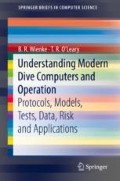Abstract
To validate computer models, diving data is necessary. In the past, data consisted mostly of scattered open ocean and dry chamber tests of specific dive schedules. In such instances, the business of correlating model and diving data was only scratched. Today, profile collection across diving sectors is proceeding more rapidly. Notable are the efforts of Divers Alert Network (DAN) and Los Alamos National Laboratory (LANL). DAN USA is collecting profiles in an effort called Project Dive Exploration (PDE) and DAN Europe has a parallel effort called Diving Safety Laboratory (DSL). The focus has been recreational dive profiles for air and nitrox. The LANL Data Bank collects profiles from technical diving operations on mixed gases for deep and decompression diving on OC and RB systems. Both have uncovered interesting trends in diving and have been used for meaningful statistical correlations of diving models.
Access this chapter
Tax calculation will be finalised at checkout
Purchases are for personal use only
References
Brubakk AO and Neuman TS, Physiology and Medicine of Diving, Saunders Publishing, 2003, London.
Hills BA, Decompression Sickness: The Biophysical Basis of Prevention and Treatment, Wiley and Sons Publishing, 1977, Bath.
Bove AA and Davis JC, Diving Medicine, Saunders Publishing, 2004, Philadelphia.
Wienke BR, Science of Diving, CRC Press, 2015, Boca Raton.
Joiner JJ, NOAA Diving Manual: Diving for Science and Technology, Best Publishing, 2001, Flagstaff.
Wienke BR, Biophysics and Diving Decompression Phenomenology, Bentham Science Publishers, 2016, Sharjah.
Schreiner HR and Hamilton RW, Validation of Decompression Tables, Undersea and Hyperbaric Medical Society Workshop, 1989, UHMS Publication 74(VAL) 1–1-88, Washington DC.
Wienke BR, Basic Decompression Theory and Application, Best Publishing, 2003, San Pedro.
Wienke BR and Graver DL, High Altitude Diving, NAUI Technical Publication, 1991, Montclair.
Blogg SL, Lang MA and Mollerlokken A, Validation of Dive Computers Workshop, 2011, EUBS/NTNU Proceedings, Gdansk.
Lang MA and Hamilton RW, AAUS Dive Computer Workshop, University of Southern California Sea Grant Publication, 1989, USCSG-TR-01-89; Los Angeles.
Vann RD, Dovenbarger J and Wachholz, Decompression Sickness in Dive Computer and Table Use, DAN Newsletter 1989; 3–6.
Westerfield RD, Bennett PB, Mebane Y and Orr D, Dive Computer Safety. Alert Diver 1994; Mar-Apr: 1–47.
Workman RD, Calculation of Decompression Schedules for Nitrogen-Oxygen and Helium-Oxygen Dives, 1965, USN Experimenal Diving Unit Report, NEDU, 6–65, Washington DC.
Buhlmann AA, Decompression: Decompression Sickness, Springer-Verlag Publishing, 1984, Berlin.
Yount DE and Hoffman DC, On the Use of a Bubble Formation Model to Calculate Diving Tables, Aviat. Space Environ. Med. 1986; 36: 149–156.
Wienke BR, Reduced Gradient Bubble Model in Depth, CRC Press, 2003, Boca Raton.
Wienke BR. Computer Validation and Statistical Correlations of a Modern Decompression Diving Algorithm. Comp. Biol. Med. 2010; 40: 252–270.
Wienke BR and O’Leary TR, Diving Decompression Models and Bubble Metrics: Dive Computer Syntheses. Comp. Biol. Med. 2009; 39: 309–311.
Wienke BR, Deep Stop Model Correlations, J. Bioeng. Biomed. Sci. 2015; 5: 12–18.
Author information
Authors and Affiliations
Rights and permissions
Copyright information
© 2018 The Author(s), under exclusive licence to Springer Nature Switzerland AG
About this chapter
Cite this chapter
Wienke, B.R., O’Leary, T.R. (2018). Computer Profile Data. In: Understanding Modern Dive Computers and Operation. SpringerBriefs in Computer Science. Springer, Cham. https://doi.org/10.1007/978-3-319-94054-0_5
Download citation
DOI: https://doi.org/10.1007/978-3-319-94054-0_5
Published:
Publisher Name: Springer, Cham
Print ISBN: 978-3-319-94053-3
Online ISBN: 978-3-319-94054-0
eBook Packages: Computer ScienceComputer Science (R0)

